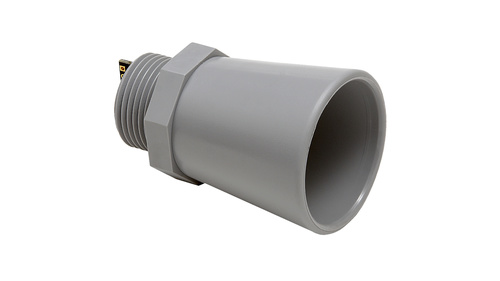Recently added
More...Categories
Suppliers
Newsletter
Once, twice in month we will send You info about new products, products on sale and news from Arduino and DIY world.
Ultrasonic range sensor Maxbotix MB7589-100 water resistant (IP67)

Maxbotix MB7589 sensor in 3/4” NPS WR housing. Range 5m, resolution 1mm, self-cleaning, output: analog, serial, PWM. SCXL-MaxSonar-WRMT series.
On stock: : n/a

| How many | Discount |
Price per piece
with VAT, in PLN |
|---|---|---|
| 1 | 707,00 | |
| 5+ | 5,00 % | 671,65 |
| 10+ | 10,00 % | 636,30 |
| 25+ | 15,00 % | 600,95 |
| 50+ | 20,00 % | 565,60 |
| Quantity discounts does not sum with other discounts | ||
Notify me when available:
Maxbotix MB7589-100
Features of the weather resistant MB7589, SCXL-MaxSonar-WRMT, include reduced impact of condensation and frost when ran continuously in closed or high-moisture environments, millimeter resolution, short to long distance detection, range information from 300mm to 5000mm to the target with the largest acoustic return, a 0.6Hz read rate, and various output options: pulse-width, analog voltage, and TTL serial.
The MB7589 from the SCXL-MaxSonar-WR line of outdoor sensors is a rugged ultrasonic sensor component module. This sensor comes in a compact and robust PVC housing which meets the IP67 water intrusion standard and matches standard electrical 3/4‑inch PVC pipe fittings (this product has multiple housing options available).
The SCXL-MaxSonar-WR sensors are factory calibrated to match narrow sensor beam patterns and provide reliable long-range detection zones.
The MB7589 is designed to report the distance to the largest acoustic return while ignoring smaller targets. When targets are of similar amplitude reflections, preference is given to the closest target. This gives users the flexibility to consistently detect larger targets in the presence of clutter and noise.
If the largest target is removed from the field of view, the MB7589 will switch to the target that gives the next largest detectable return. This filtering makes the MB7389 one of our most advanced sensors for outdoor tank and bin applications.
In addition, the MB7589 offers virtually noise free distance readings through the use of high-output acoustic power combined with continuously variable gain, real‑time background automatic calibration, real‑time waveform signature analysis, and noise rejection algorithms. This holds true even in the presence of many of the various acoustic or electrical noise sources.
Specification:
- Resolution of 1-mm
- Self‑cleaning transducer
- 0.58Hz read rate
- Internal temperature compensation
- 42kHz ultrasonic sensor measures distance to objects
- RoHS Compliant
- Read from all 3 sensor outputs: Analog Voltage, Serial, Pulse Width
- Virtually no sensor dead zone, objects closer than 30cm typically range as 30cm
- Operates from 2.7-5.5V
- Low 68mA average current requirement
- Small, light weight module
- Designed for easy integration into your project or product
- Operational temperature -40°C to +65°C (-40°F to +149°F)
- Real-time automatic calibration (voltage, humidity, and ambient noise)
- Firmware filtering for excellent noise tolerance and clutter rejection
- Weather resistant (IP67), optional chemical resistant F-Option
- Matches standard electrical 3/4-inch PVC pipe fittings for easy mounting (3/4-inch National Pipe Thread Straight)
- Long, narrow detection zone
- Our most advanced, weather-resistant, ultrasonic sensor
- Additional stability filter rejects anomalous readings
- Detects the largest signal return in the field of view
- Uses the complete dynamic range of the sensor, if no large targets are present the sensor will select the next smallest target in view
- Can be used to range large objects behind small obstructions
- Best sensor for bin and tank level measurements where icing has occured
- Maximum range of 500 cm (196 inches)
Recently added
More...Categories
Suppliers
Newsletter
Once, twice in month we will send You info about new products, products on sale and news from Arduino and DIY world.















